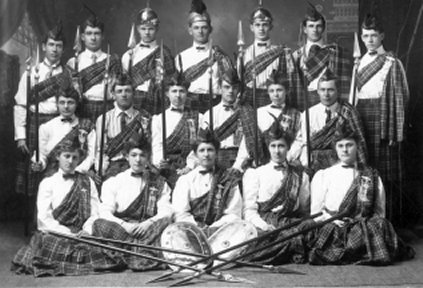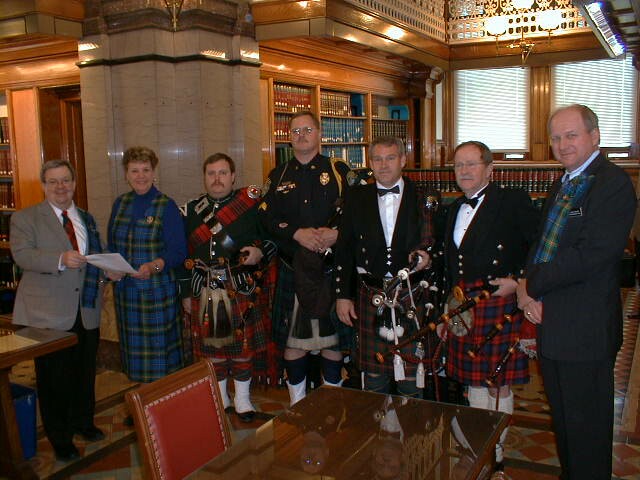The Iowa Tartans
Iowa's Scottish Heritage
by Todd Wilkinson
While nowhere as large as their fellow immigrants from Germany or the Scandinavian countries, Iowa has also been home to a number of Scottish immigrants, who worked as farmers, coal miners and sheepherders across the Hawkeye State. Scottish immigration gradually increased from the early 1850s (Iowa became a US state in 1846) so that by 1890, some 7,000 Scottish immigrants were recorded in the Federal Census as residing in Iowa, according to Dorothy Schwieder’s Iowa: The Middle Land.
US Army Surgeon Samuel Muir, a native of Edinburgh, is credited with being the first European settler at Keokuk, who left the army after objections were raised about his Sauk Indian wife. Muir replied to his critics, “May God forbid that a son of Caledonia should ever desert his child or disown his clan!”
Another Iowa “river city”, Davenport, claims Dundee native James MacKintosh as one of its founding fathers. MacKintosh, the grandson of a veteran of the Battle of Culloden, opened a dry-goods store in the new settlement of Davenport, as well as serving as Iowa’s first bookbinder, land speculator and surveyor. MacKintosh was killed serving in the Union Army during the Civil War.
Another Civil War veteran, Glaswegian Andrew McDonald, the “fighting plumber” of Dubuque, immigrated to the United States in 1854 and soon gained a reputation in the Mississippi River valley as a skilled plumber. In 1861, a little under a year of becoming an American citizen, McDonald joined the 1st Iowa Infantry and was wounded at the second major battle of the Civil War, Wilson’s Creek, Missouri. McDonald, who was left on the field, was taken as a prisoner by the Southerners, and even met a fellow Scot from his days in St. Louis who was serving with the rebels. McDonald was eventually released and returned to Iowa, where he promptly re-enlisted and was wounded again at the Siege of Vicksburg, Mississippi in 1863. During that time, he was granted a patent on a screw wrench, otherwise known as the “monkey wrench”. The company he founded, A.Y. McDonald manufacturing, is still in business today.
Settlements of Scottish immigrants could be found in Southeastern Iowa, such as Tranquility, in Appanoose County, where a description of young Scots at Kirk (church) in “velvet tams and kilts” was given by a fellow expatriate and writer, Janette Stevenson Murray. The town of Scotch Grove, in Jones County, was founded by Highlanders in the late 1830s from the failed Red River (Canada) Colony of Lord Selkirk, and during the 1870s a Scottish evangelist preached a sermon in Gaelic in the Presbyterian Church of Scotch Grove, causing many an old settler to shed a tear for their native land.
Scottish settlements in Cedar (Red Oak Grove) and Poweshiek Counties were settled largely by immigrants from Aberdeenshire in Northeastern Scotland, who located first in Ohio in the 1830s before moving to Iowa in the 1840s and 50s. Unlike some immigrants, who were attracted to settlements by professional recruiting agents, the majority of the Cedar and Poweshiek Scots came because of communication between friends and relatives. Marjory Harper’s Emigration from North-East Scotland gives a very detailed account of these Iowa Scots. Other Scots from the North-East and Aberdeen were enticed to Des Moines County in 1848 with a description of large, cheap and fertile tracts of lands in the October 25, 1848 edition of the Aberdeen Journal.
Immigrants from Ayrshire made their way to Wolf Creek in Tama County, where native Scot Congressman James Wilson resided. Wilson later served as Secretary of Agriculture under Presidents McKinley, Roosevelt and Taft. The Scots of Southeastern Iowa were known for being being “clannish”; Murray says of the Scots of Iowa that they were “bound as a homogenous group by the three strong ties of race, religion and family.”
In Northwestern Iowa, the annual “Scotch reunion” at Ida Grove was a very popular event that even non-Scots attempted to obtain invitations to with attempts to “trace a great-aunt or maybe a 42nd cousin back to the highlands.” At the reunion, there were Highland dancers and pipers, lead by local restaurant owner Major Cameron, “in highland regalia”. The majors’ three granddaughters were continuing the tradition as late as the 1930s, and the festivals continued into the 1950s. One descendant of the Ida County Scots, Judith Bauer, remembers being shown how to do a sword dance “around 2 crossed yardsticks on the kitchen floor!”
Ida Grove also boasted a “castle” of the Royal Highlanders. Organized in 1896 in Aurora, Nebraska, the Royal Highlanders was originally a fraternal insurance organization. The organizations’ headquarters building in Aurora was reportedly modeled on Balmoral Castle in Scotland. The order’s purpose was “to unite for mutual benefit and fraternal protection all white persons who are in good health, of exemplary character, and between the ages of 16 and 65.”
There were two classes of membership, benefit and social. The ritual of the Royal Highlanders was based on the story of William Wallace and Robert the Bruce in their struggle for Scottish independence, and was intended to teach “Prudence, Fidelity and Valor”. Degree teams wearing kilts and glengarries and carrying shields and spears initiated new members into the Order. The orders emblem even bore the heart of Robert the Bruce.
In 1930, the Order numbered some 17,000 members, both men and women, with “extensive investments” in Nebraska farmland. Seven years later, the Order reincorporated to become a mutual life insurance company, and renamed itself the Lincoln Mutual Life Insurance Company in 1946.
An article from the Ida County (Iowa) Pioneer Record from 1946 documents the history of the local Royal Highlanders castle, which was formed in 1898 with a charter membership of 35 businessmen and citizens. In 1902, the castle organized a membership drive to “make the society one of the largest organizations in Ida Grove.” Within a short time, 70 new members were secured, and on July 31, 1902, the “Bonnie Doon” drill team, along with Royal Highlanders President W.E. Sharp and his wife, came from Lincoln Nebraska to participate in the initiation ceremonies.
The next year, the Ida Grove castle began to organize its own drill team, which was outfitted in “plaid kilties, bright shields and spears”. The drill team then helped institute new castles in nearby towns of Danbury, Odebolt and Holstein. The Ida Grove drill team was “ranked among the best in the state”, according to the article, and even attended the Royal Highlanders’ national meeting in Denver, Colorado in September, 1909, it being the “only team from Iowa”.

The Drill Team of Ida Grove Castle No. 130, Royal Highlanders, Ida Grove, Iowa, circa 1909. Photo courtesy of Judith Bauer, whose grandfather, J.E. Moorehead, is the second from the left on the back row.
The town of Odebolt also had a Robert Burns Society, with members made up from the Scottish farmers of Ida and Sac Counties. A newspaper account of the Burns Supper of 1906 lists the “bill o’ fare” for the evening, complete with piping, songs and poems from Burns and of Scotland, Scottish Country & Highland dancing (including a sword dance) and a party which continued on until 7.00 am – the evening’s festivities had begun at 7.00 pm! The Odebolt Opera House was the venue for the 147th anniversary of the birth of the ploughman poet.
Dubuque, Iowa, also celebrated the life and works of Robert Burns with a Burns Supper near the 100th anniversary of the ploughman poet’s birth in 1859, and then later with a St. Andrew’s society, which celebrated Burns’ birthday and St. Andrew’s Day on November 30th, as well as providing mutual aid “to the unfortunate and poor whether or not they were Scottish.” It is interesting to note that the society suffered a schism in December of 1859 over the issue of temperance!
In 1936, Colonel George Dailey of the University of Iowa’s Reserve Officer Training Corps (ROTC) program organized a pipe band to perform at Iowa football games after seeing the band of the Black Watch while overseas in the First World War. During the Second World War, the band became all-female in membership due to male students serving in the armed forces. Over the years the band has performed in parades and festivals across Iowa, the United States and the world, and has played for a number of US Presidents and other dignitaries. The university cut the band’s funding in 1981, but it still operates today as a student interest group.
Today, The Scottish Heritage Society of Iowa, with its three chapters, continues the efforts of these earlier organizations to promote Scottish heritage and culture.
Other Iowans of Scottish heritage include Henry Wallace, who served as Secretary of Agriculture and Vice-President under Franklin D. Roosevelt, as well as a presidential candidate in 1948; The noted author Norman Maclean, who wrote a fictionalized version of his Scottish-American family’s story in A River Runs Through It and one Marion Robert Morrison of Winterset, who later changed his name to John Wayne.
The Iowa Tartans
Ann Gerdts, the former President of the Iowa Scottish Heritage Society (ISHS) and Mark Osweiler met at a Scottish festival in 2002 and began to discuss the possibility of an Iowa state tartan to honor the many aforementioned contributions to Iowa history by Scottish and Scots-Irish settlers. Osweiler, an Iowa native and member of the Scottish Tartans Authority, had already designed a tartan for Minnesota in February of 2002.
Osweiler produced over 50 different computer-generated tartans, based on the suggestions of the officers of the Hawkeye Grand Gaelic Isles Society of Cedar Rapids, Iowa (HAGGIS), who suggested colors associated with the state: Green and yellow for Iowa’s corn; red, white and blue for the Iowa state flag; red for Iowa’s famous barns, white and blue for snow and sky and brown and black for Iowa’s soil. HAGGIS is one of the three regional chapters of the Iowa Scottish Heritage Society.
“I was just trying to incorporate things that would symbolize Iowa, being from Iowa this was very important and had to say something to me,” said Osweiler.
Osweiler’s wife Nydia served as an editor of sorts, and helping him narrow down the number of choices before the designs were unveiled to the public. “A lot of the designs were very similar, just a slight change in thread count or slight variation in color,” stated Osweiler.
The designs were displayed at the Cedar Rapids Scottish Festival in 2002 and the public attending were asked to cast their vote for their favorite design for not only the state tartan, but a “dress” variant as well. “The visitors at the festival were very responsive to idea,” said Osweiler. “Many did not know there were state tartans and did not know at the time that over twenty states had them.”
After the votes were counted, the top two designs were presented a board meeting of the ISHS, where the designs were approved by all three Scottish heritage organizations in the state. Osweiler would have liked to have polled the visitors at Iowa’s other Scottish heritage festival in Dubuque, but was not able to due to time constraints. “I am very confident that they would have also chosen the same design,” said Osweiler.
Robbie Stinson, a piper from Douds, Iowa, contacted members of the Iowa General Assembly in an effort to raise support for the adoption of the tartan as the state’s “official” one. Stinson, a former member of the Scottish Heritage Society of Des Moines, currently plays with a local pipe band known as the “Drouthy Ducks” and presents a yearly program for St. Andrew’s Day. Like Osweiler, Stinson was motivated in his efforts by the fact that neighboring states, such as Minnesota, had already adopted tartans.
On March 19, 2003, Senator Maggie Tinsman of Davenport filed Senate Concurrent Resolution No. 10 with the Iowa General Assembly to adopt “the designs submitted by the Iowa Scottish Heritage Society as the Iowa tartan and the Iowa dress tartan as the official Iowa tartan.” The next year, Representatives Dave Heaton of Mt. Pleasant and John Whitaker of Hillsboro introduced House Resolution 149, which also called for the official adoption of the Iowa and Iowa dress tartans.
Representative Heaton noted that there was strong support for such a “good gesture” in the Iowa General Assembly when the resolution was brought to a vote.
On April 6, 2004 the tartans were presented to the Iowa state legislature in Des Moines. Gerdts was piped into the chambers and then resolutions officially adopting the tartans were read and passed unanimously. Gerdts noted that a number of legislators were wearing small tartan rosettes as a show of support. Afterwards, a reception was held in the Iowa State Library on the third floor of the capitol building.

The Iowa tartan was registered with the Scottish Tartans Authority in September, 2004 (ITI # 6051) along with the Iowa dress tartan (ITI # 6382). Both tartans were recently mentioned in Brian Wilton’s Tartans.
“The response [to the tartans] has been wonderful,” said Gerdts, in an e-mail. “We have had inquires from all over the USA for the tartans.” Gerdts noted that the Iowa tartan has even been adopted by the Waukee, Iowa High School Pipe Band as their official uniform. Osweiler is very proud of this, stating that while the Minnesota tartans were his first design projects, no pipe band in that state has adopted the tartans.
“When folks see it, they like it,” noted Stinson about the Iowa tartan. “People are enthusiastic about it.”
Besides the Iowa and Minnesota tartans, Osweiler also designed the Clan MacAlister Dress tartan in 2005, in honour of the Chief’s son, Ranald McAlister. The tartan is also the official tartan of the Clan MacAlister Society of the United States.
In an article in the November, 1923 journal of the Iowa State Historical Society, author Bruce Mahan, in telling the story of the Highlanders of Scotch Grove, Iowa, stated: “Let them honor their “tartans” or “plaids” – backgrounds of green or black or red or blue with fine overlay in lines of contrasting color. Let them thrill with pride to hear the songs of Old Scotland. It is their rightful heritage.”
No doubt that Mahan’s words live on the modern-day Scots and Scottish-Americans of Iowa and their efforts to preserve a proud heritage.
PHOTO: The author, Todd Wilkinson, wearing his Iowa tartan kilt on the site of his family’s farm in Wright County, Iowa, about 5 miles southeast of Clarion.
Works Cited
Books
Federal Writers Project, Works Progress Administration. The WPA Guide
to 1930’s Iowa. Iowa City: University of Iowa Press, 2007.
Harper, Marjory. Emigration from North-East Scotland: Willing Exiles
(Volume 1). Aberdeen: Aberdeen University Press, 1988.
Hewitson, Jim. Tam Blake & Co.: the story of the Scots in America.
Edinburgh: Canongate Press, Ltd., 1993.
Schmidt, Alvin J. Fraternal Organizations. Westport, Connecticut:
Greenwood Press, 1980.
Schwieder, Dorothy. Iowa: The Middle Land. Ames: Iowa State University
Press, 1996.
Van Der Zee, Jacob. The British in Iowa. Iowa City: The State Historical Society of Iowa, 1922.
Articles
Mahan, Bruce. “The Scotch Grove Trail.” The Palimpsest, Iowa State Historical Society, 1923. http://www.rootsweb.ancestry.com/~iajchs/the_scotch_grove_trail.htm
“Highlanders Institute Castle Here in 1898.” Ida County (Iowa) Pioneer Record, 1945.
Web sites
A.Y. McDonald Manufacturing Company, Dubuque, Iowa: http://www.aymcdonald.com/about_history.cfm
“Andrew Young MCDONALD” (Encyclopedia Dubuque): http://www.encyclopediadubuque.org/index.php?title=MCDONALD%2C_Andrew_Young
“Benevolent Societies” (Encyclopedia Dubuque): http://www.encyclopediadubuque.org/index.php?title=BENEVOLENT_SOCIETIES
“Kintyre Connections” (The Odebolt, Iowa History Pages): http://www.rootsweb.ancestry.com/~iaohms/kintyre_connections.html
“The Official Iowa Tartans”: http://www.haggis-iowa.com/iowa_tartans.html
“University of Iowa Scottish Highlanders Pipe Band”: http://www.frontiernet.net/~mkisa/index.html
“Representative Dave Heaton”: http://www.daveheaton.net/D-91/News/tartans.htm
“The Royal Highlanders”: http://www.stichtingargus.nl/vrijmetselarij/highlanders.html
“Sickness & Death in the Old South: The Royal Highlanders”: http://www.tngenweb.org/darkside/trh/
“Nebraska State Historical Society – The Royal Highlanders”: http://www.nebraskahistory.org/lib-arch/research/manuscripts/organize/royal-highlanders.htm
A special thanks to the following individuals for personal correspondence via e-mail and telephone:
Ann Gerdts
Judith Bauer
Representative Dave Heaton
Barb Horak
Mark Osweiler
Robbie Stinson

